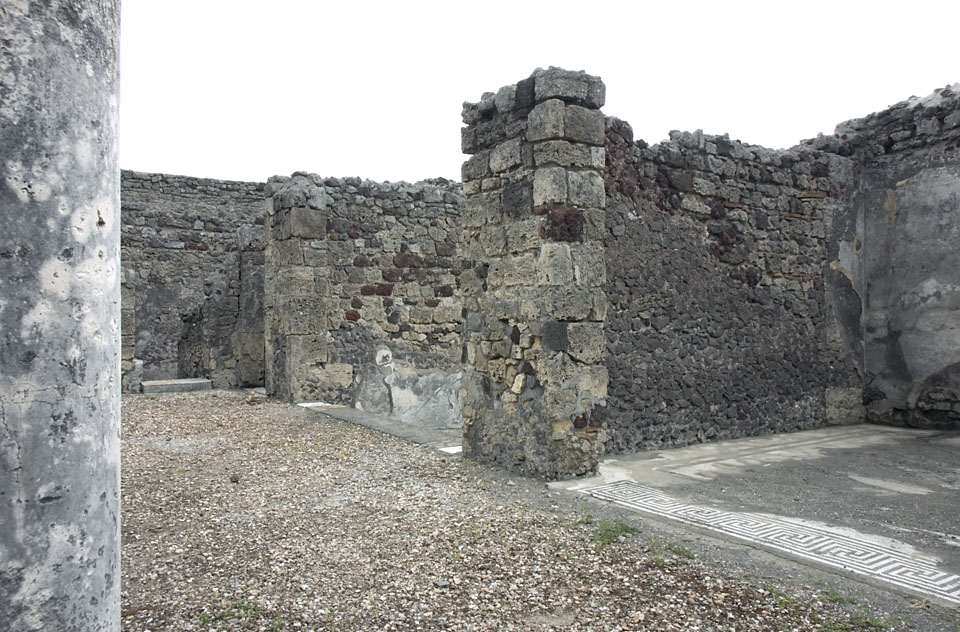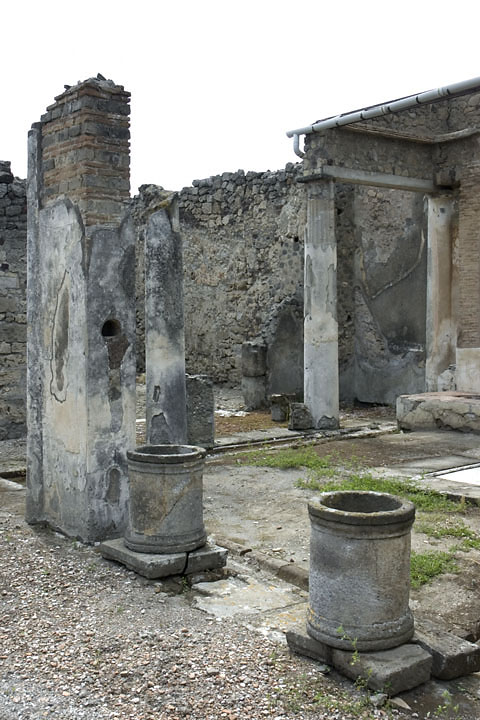S portico
Description
Thomas Staub
S portico: Length of the stylobate: 8.90 m, and width of stylobate: 0.63 - 0.65 m. The south portico has three columns; a fourth one might originally have stood between the south-east corner column and the next one, and would then have been removed when the fountains in this portico were installed. The intercolumnium between the south-east column and the first one to the west is 5.05 m, and between this and the column of the south-west corner is 2.15 m.
The south-east tuff-block of the stylobate is 0.65 m wide. On this, the column is placed; its diameter is, because of the attached fountain wall, not measurable. The cocciopesto floor seems to have covered the plate of the stylobate and is visible under the plaster of the column. Plaster covers most of both the column and the attached wall, only at a few places has the coating fallen off, leaving the building material visible. The column is erected of tuff drums (height not measurable), and in the lower part, were these drums facetted, whereas the upper part originally showed cannelures. The wall containing the fountain (width 0.56 m, d: 0.45 m, max. preserved height 2.15 m) was set against the tuff drums of the column and then covered with plaster. The wall is constructed in opus vittatum mixtum of one layer of tuffeli (ca. 0.20 x 0.07 m) and three layers of bricks (height 0.03 - 0.04 m) in a yellowish mortar. On its front side, at 1.65 m height, a small niche (0.20 x 0.20 m) served as water outlet (the opening of the pipe is still visible). Bricks, the ones constructing the arch on top placed in trapezoid forms, frame the niche. Two vertical cracks are visible from the bottom of the front side up to the fountain niche, either after repairs in the piping system or provoked by the humidity around the pipe.
The next plate of the stylobate is 1.20 m wide and shows round in carvings for placing of the pipe feeding the fountain in the above-described wall. On this plate, a tuff-drum (height 0.70 m,  ext. 0.57 m, int. 0.43 m) is placed (on a 0.72 x 0.64 m large, 0.12 m high plate), which received the water from the fountain. The drum is triple profiled on the bottom and the top, and is still showing remains of the white chalk wash, with which it was covered. The next plate of the stylobate is 0.85 m, and the next 0.45 m wide. Into that third plate, some in carvings are visible: two parallel ones on the western side, 0.06 - 0.08 m wide, 0.25 m long, and one parallel narrower one (width 0.03 m) and, finally, one slightly curved at the south-west corner (width 0.06 m, d: 0.07 m), that continues in the next plate. That plate, 1.15 m wide, also shows some in carvings, besides the one that continues from the former plate for 0.25 m before it is covered by the fundament of the second tuff-drum (see below). There is another rounded one, starting ca. in the middle of the plate running towards the northern side of it, which is also covered by the stone block underneath the second drum and which might reappear under the southern rim of that block. The block and the drum on top it resembles the one in front of the eastern fountain of this portico and has app. the same dimensions. Underneath, remains of the cocciopesto pavement are visible.
Also, the next plate of the stylobate shows several in carvings, running from north to south, which continue under the west wall with a fountain, built against the second column of this portico. The first of these, 0.05 m from the eastern rim, is 0.05 m wide and 0.06 m deep, and contained the lead pipe (some remains visible), feeding this fountain with water. The next one is situated 0.15 m from the east corner, and is 0.07 m wide, 0.06 m deep, and might correspond with an incurving in east-west direction in the block of the gutter in front of it. A third incurving (0.05 x 0.06 m) is situated 0.35 m from the east corner and seems to run diagonally towards the south-west. The column placed on this plate is preserved for 3.60 m height and is largely covered with plaster. The visible parts at the top, again, consist of cannelured tuff-drums. The wall abutting against this column has a max. preserved height of 3.80 m and is covered by the continuing layer of plaster from the column up to a height of 2.50 - 3.10 m. Where the structures of this wall are visible, i.e. at the upper parts, the construction is, once again, in opus vittatum mixtum, with two rows of bricks alternating with one row of tuffeli with the same measurements as in the eastern one. At its eastern front, the niche for the fountain is placed at 1.60 m height, measuring 0.17 x 0.17 m, with a d of 0.25 m (pipe is coming out at 0.07 m d). The humidity has as well created some cracks in the plaster, but in the lower part, the plaster is unharmed, thus showing that the pipe was inserted before the wall was plastered.
The next plates of the stylobate are 1.00 m, 1.03 m, and in the south-west corner, 0.65 m wide, all without any in carvings. The column of the south-west corner has a  of 0.52 m and a max. preserved height of 2.85 m, once again nearly completely covered with plaster. Only at a few places is this coating damaged, and the core of the column in cannelured tuff drums is visible. In 0.62 m height, remains of iron, probably from a nail, are visible on its western side. The cocciopesto pavement of the portico reaches under the plaster.


